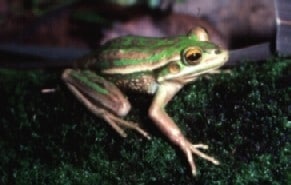-
Striped marsh frog
Scientific Name: Limnodynastes peronii This frog is commonplace on the east coast of Australia and has a distinctive “thok” sound that it makes nightly throughout the year. It is light to dark brown with darker stripes and blotches and a whitish stripe running down the centre of its body. It grows to 6.5 centimetres long […]
Continue reading -
Peron’s Tree Frog
Scientific Name: Litoria peroni The general colour of the Peron’s tree frog is a mottled brown or grey with a bright yellow and black pattern in the groin and inner surfaces of the thigh and small green specks on the dorsal surfaces. This species can change colour in seconds depending on temperature, light exposure and […]
Continue reading -
Magnificent tree frog
Scientific Name: Litoria splendida The big, fluid filled sac on the top of this frog’s head is a poison gland, the biggest of any amphibian in Australia. Luckily the foul tasting poison doesn’t affect humans, but it does deter birds from eating the frog. Magnificent tree frogs are olive to bright green with whitish/yellow spots […]
Continue reading -
Green Tree Frog
Scientific Name: Litoria caerulea The green tree frog is usually a beautiful bright green, though, depending on the mood of the frog, this may sometimes fade to a dark khaki-green. Some specimens also have white spots that are outlined in darker colours. The underside is creamy-white. In its adult stage, a female green tree frog […]
Continue reading -
Green and Golden Bell Frog
Scientific Name: Litoria aurea The green and golden bell frog has smooth skin, usually green, with a variable pattern of golden brown blotches. It has a creamy-gold stripe along the side of the body, from the eye to the hind legs. The inside of the thighs are distinctly coloured in turquoise-blue. The tadpoles are dark […]
Continue reading -
Cane Toad
Scientific Name: Bufo marinus The cane toad is large, reaching up to 23cm in length. It has highly visible poison glands located near the back of the head. The back and legs of the cane toad are covered in wart-like lumps and its skin has a leathery appearance. Habitat: The cane toad was originally from […]
Continue reading -
Platypus
Scientific Name: Ornithorhynchus anatinus Proudly Sponsored by Brenna Tarrant, Blaxland NSW Azalea and Shira Akbarian, Kariong Azalea and Shira Akbarian, Kariong Did You Know? The male platypus has a spur on the inside of its hind leg which is it’s only defence. The spur contains poisonous toxins that can cause a painful, although not fatal, […]
Continue reading -
Dingo
Scientific Name: Canis familiaris dingo Proudly Sponsored by Kaeden Easton, Ourimbah, NSW Mathew Curth, Yarrawah, NSW Bailey Green, NSW Lorna and Ashley Rushman, Crawley, England Kaeden Easton, Ourimbah ETHAN PINCOTT, Sydney Rozalie Hardy, Morwell Did You Know? It is thought that the dingo has been almost solely responsible for the extinction of the Tasmanian tiger […]
Continue reading -
Parma Wallaby
Scientific Name: Macropus parma Proudly Sponsored by Sue Nolan, Bensville Did You Know? Parma wallabies were believed to have become extinct in the early part of last century. They were then discovered to be thriving on an island in New Zealand, where they had been introduced. Great efforts were then made to transport some of […]
Continue reading -
Common Wombat
cientific Name: Vombatus ursinus Proudly Sponsored by Alison Young, Goulburn, NSW Michael & Susan Tait, Kariong, NSW Joanne Brekelmans, Ingleburn, NSW Brett & Beck Eggleston (Jewellery on Argyle), Picton NSW Alison Young, Copacabana Shannen Hutcheson, Tumbi Umbi Mirella Baker, Port Macquarie Scott Green, Baulkham Hills Louis Gallagher, Luton, England Laura Jauneau, Caen Jackye Longton, Buderim […]
Continue reading










